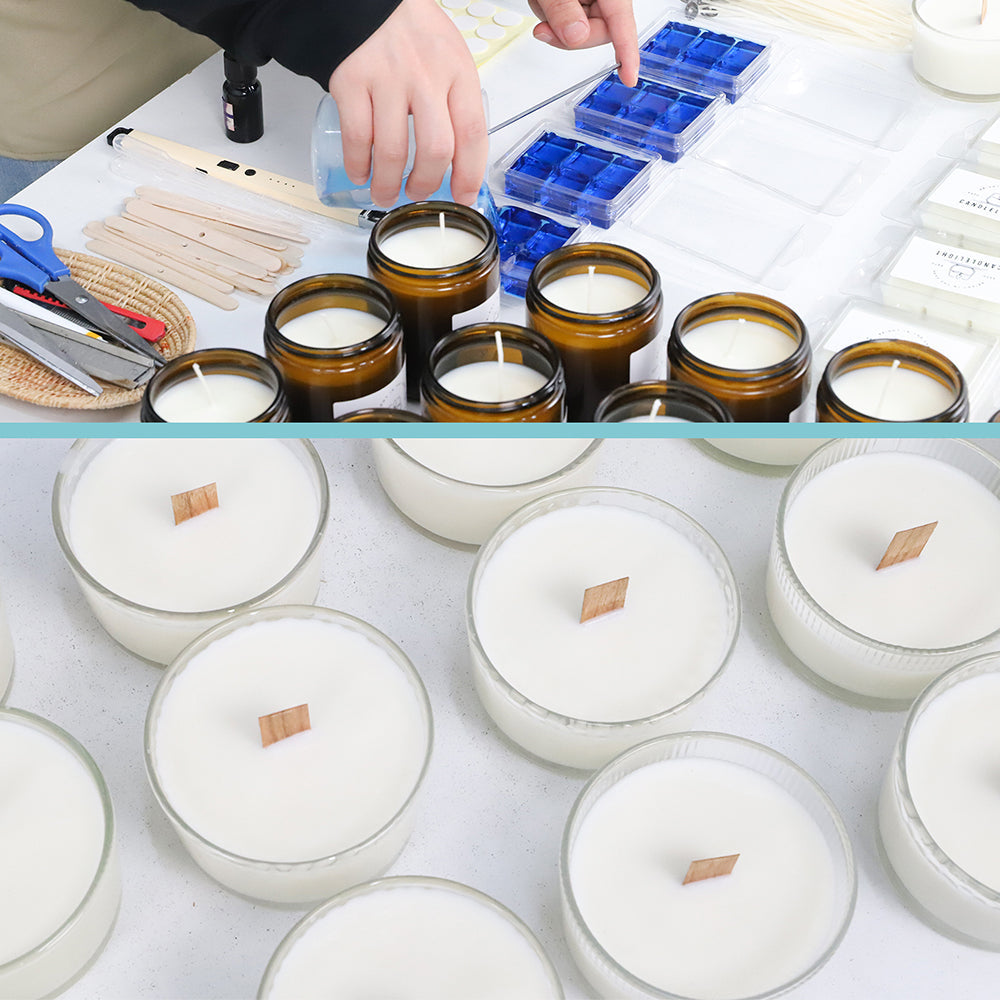
How to Choose the Right Candle Wick
Share
There's nothing more frustrating than spending time and money on a beautiful candle, only to have it tunnel, smoke, or drown. The secret to a perfect, clean-burning candle isn't just the fragrance or the wax—it's the wick.
Choosing the right wick is the most critical step in candle making. It’s the engine of your candle, controlling everything from flame size to hot throw. This guide will demystify the process and give you the knowledge to select the perfect wick every time.
Why Your Wick Choice Matters More Than You Think
The wrong wick can ruin an otherwise perfect candle. Here’s what’s at stake:
Tunneling: A wick that's too small can't melt wax to the edges of the container, leaving a ring of unmelted wax and wasting your product.
Soot & Smoke: A wick that's too large will create a large, flickering flame that produces excessive soot (black smoke) and can be a fire hazard.
Poor Scent Throw: An incorrectly sized wick won't create a properly sized melt pool, which is essential for effectively dispersing fragrance into the air.
Fast Burn Time: An oversized wick will burn your candle too quickly, reducing its lifespan.
The Main Types of Candle Wicks: Pros and Cons
1. Cotton Wicks
The most common and versatile type. They are typically braided and often come pre-waxed for easier handling and a cleaner initial burn.
Best for: Container candles, pillars, votives. A great all-rounder, especially for beginners.
Popular Variants: Flat braided wicks (good curl, self-trimming) and square braided wicks (stable burn).
2. Wooden Wicks
These have surged in popularity due to their aesthetic and the soft, crackling sound they make—reminiscent of a fireplace.
Best for: Container candles, especially in rustic, luxury, or natural-themed products.
Consideration: They require more precise sizing than cotton wicks. Too wide, and they can struggle to stay lit; too narrow, and the flame may be weak.
3. Paper Wicks
Often stiffened with a paper core, these wicks are designed to stay upright and are commonly used in votives and pillars.
Best for: Free-standing candles like pillars and votives where a rigid wick is necessary.
Consideration: Less common in modern container candles.
The #1 Factor: Wick Size and Diameter
Type is important, but size is everything. Wick sizing is usually denoted by a number and letter (e.g., LX-22, CD-12, HTP-104). A higher number generally indicates a larger wick designed for a wider container.
The Golden Rule: The goal is to achieve a full melt pool (liquid wax reaching the edges of the container) that is approximately ¼ inch deep within 2-4 hours of burning.
Too Small: Melt pool doesn't reach the edges → Tunneling.
Too Large: Melt pool is too deep too fast, flame is large and sooty → Sooting & Fast Burn.
Pro Tip: Always refer to a Wick Size Chart from your supplier. These charts are your best friend and provide recommendations based on wax type and container diameter.
Matching Your Wick to Your Wax Type
Different waxes have different densities and melt points, which drastically affects wick choice.
Soy Wax: A softer, cleaner-burning wax. It typically requires a larger wick than paraffin to achieve the same melt pool size. Popular wick series for soy are CD, CDN, and ECO.
Beeswax: A very dense wax with a high melt point. It requires a specialized, larger wick designed to generate enough heat. Square braided cotton wicks are a traditional and excellent choice.
Paraffin Wax: A standard wax that is less dense. It works well with a wide variety of wicks, including LX and HTP series.
Coconut Wax: A soft wax similar to soy. ECO and CD wicks are often a good starting point.
How to Professionally Test Your Candle Wick
Never skip this step! Testing is non-negotiable for a quality product.
Make a Test Candle: Use your exact recipe—same wax, same fragrance oil load (e.g., 10%), same container.
Burn in Stages: Let the candle cure fully (especially for soy wax). For the first burn, let it lit for 4 hours and measure the melt pool.
Document Everything: Take notes on flame height, mushrooming, melt pool depth, and scent throw.
Adjust: If the wick is too small, try the next size up. If it's too large, try the next size down.
Pro Tip: The Importance of Proper Wax Melting
A key to consistency in testing—and in your final product—is evenly and gently melted wax. Burnt or overheated wax can degrade fragrance oils and change the wax's properties, leading to inconsistent results that you might mistakenly blame on the wick.
This is where a double boiler or, better yet, a professional wax melter shines. For serious chandlers looking to improve efficiency and consistency, a dedicated melter is a game-changer. For instance, Toauto wax warmers and melters are designed to melt wax gently and evenly, preserving the integrity of your materials and ensuring your wick tests are accurate. This is especially crucial when working with natural waxes like soy and beeswax.
Ready to upgrade your candle making setup? Explore the range of efficient and reliable Toauto wax melters to achieve perfectly melted wax for every batch, taking the guesswork out of your process.
Final Checklist for Choosing a Candle Wick
Determine Wax Type: What are you using? (Soy, Paraffin, Beeswax, Blend)
Measure Container Diameter: What is the inner width of your vessel?
Select Wick Type: Based on aesthetics and performance (Cotton, Wood, Paper).
Consult a Size Chart: Use your supplier’s chart to find a starting point.
TEST, TEST, TEST: Burn your test candle and meticulously document the results.
Adjust and Repeat: Don’t get discouraged. Finding the perfect wick is a science.
By following this guide, you'll move from guessing to knowing, creating candles that are not only beautiful but also safe, clean-burning, and highly fragrant. Happy crafting!
